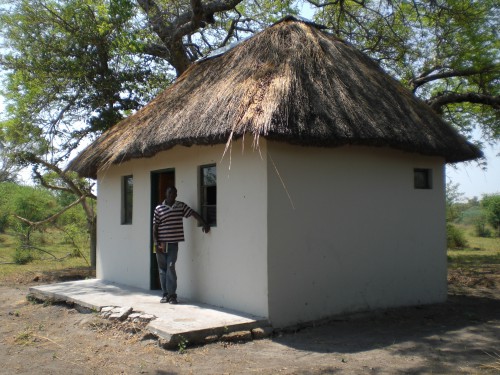
Driving through the bush in Caprivi last week, heading for the magical Nkala Lupala conservancy, I passed a sign pointing down a rough track indicating the David Livingstone Museum. I was surprised. Neither the Regional Governor nor the Mayor of the nearby regional capital Katima Mulilo had mentioned the existence of a British-linked attraction despite our discussions of a number of British ties and ventures in this fascinating north eastern corner of Namibia. The sign had a mobile phone number for visitors to alert museum personnel. I tried ringing it but couldn’t get a signal. Unsure of how far up the track the museum was located, and already struggling with the tricky sand roads (real 4 by 4 territory) beyond Sangwali village, I decided to find out more about it at the nearby lodge where I was spending the weekend to avoid getting stuck out in the bush with the sun going down.
The lodge manager told me that the small museum was run by a local farmer, Linus Limbo Mukwata, whose interest in Livingstone had been brought alive by his father’s stories about the Scottish missionary’s exploits in the area. It was well worth a visit – and he helped me to track down Linus and arrange a visit for the following day.
The museum turned out to be located only a few kilometres down the track and Linus was waiting outside it when I arrived the following morning. He said his father had told him stories as a child about the explorer’s links with the local Makololo tribe and he had been fascinated to learn all about his travels. He decided to found a museum to mark Livingstone’s history in the area on the site of one of his missionary stations. He was passionate in his belief that it was important to keep history alive.
The museum is housed in a simple whitewashed room with a thatched roof so typical of the area. It boasts some impressive wall maps charting the missionary’s travels, framed photos of key characters from his life obtained from the Missionary Society, as well as posters on local customs and crafts, such as basketry. It was a fascinating discovery and, indeed, well worth a visit. Linus is passionate about his hobby and delighted to share his knowledge of local history and customs.
I asked Linus how he had managed to fund the museum. It turned out this had been a real stroke of luck. He had managed to track down the English family of one of Livingstone’s contemporaries and uncovered a tragic tale of loss and betrayal that forms a central piece of the site. During his time in the area, Livingstone had developed strong links with the local chief, Chief Sekeletu. When he left Linyanti in 1855, he promised the chief he would come back to set up a permanent missionary station. But during his travels, he changed his mind and wrote to the London Missionary Society to send someone else and they sent Holloway Helmore and his young family, who had been working at a mission station in South Africa. They had a terrible journey travelling 6,000 km from the Cape by ox wagon through the Kalahari in the dry season.
On their arrival in Linyanti, Chief Sekeletu didn’t take to Helmore in the same way as Livingstone and was suspicious about the party’s presence. What happened next has been passed down through the generations of local villagers, who believe that the chief ordered that the missionary party’s meat and drinks be poisoned. Whether what happened subsequently was as a direct result of this order or not, there followed a series of tragic deaths that devastated the attempt to found the Makololo mission and ultimately drove the party out. On 7 March 1860, Helmore’s 3-year-old son Henry died, followed soon after by Eliza Price, the 5-month-old daughter of his fellow missionary companion Roger Price. On 11 March, Helmore’s 8-year-old daughter Selina died and then his wife Anne the day after. Holloway himself died at the age of 44 on 21 April. After that, Roger Price decided to abandon the mission with Helmore’s two remaining orphaned children, only for his 30-year-old wife Isabella to die on the journey out through Zambia on 5 July.
It was a tragic tale but miraculously did not put off the Helmore family from wanting to mark its connections in far off Namibia. In 1999, Linus was put in touch with Stella Kilby, the great great grand-daughter of Holloway and Anne Helmore. She gave him funds to found the museum in memory of her ancestors. Her daughter Petrina came out from Sussex in England to visit the museum after it was opened in 2001.
The museum now needs investment to maintain it as it is suffering from its location out in the bush. The roof needs re-thatching and an infestation of nasty looking wasps needs tackling. It would be wonderful if any assistance could be found to secure the future of this little known chapter of the great missionary and explorer’s work in this distant corner of Namibia. His links to Zambia and Botswana are much better known and marked but his connections with the Makololo and Chief Sekeletu in Namibia should not be overlooked.
It would be fitting to try and include help to secure this fascinating homage to the man and his work in the extensive plans to mark the bicentenary of his birth next year in 2013. I would be most grateful for any ideas or institutions to contact to get help for Linus to do this.
